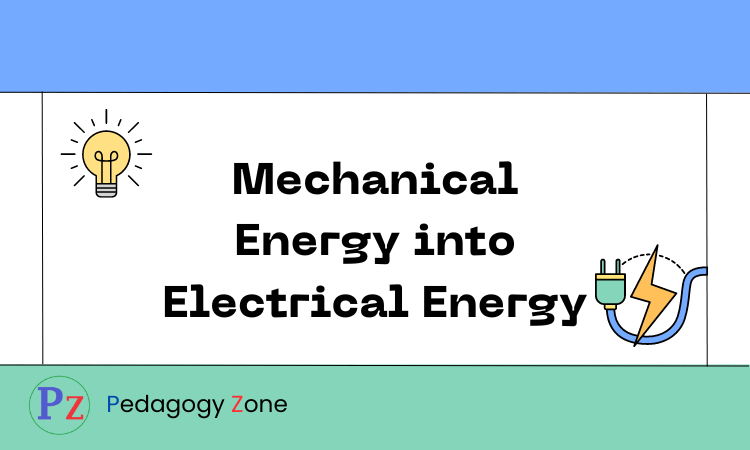Have you ever wondered how we get electricity from wind or water? It’s like magic—but it’s all science! The process of turning mechanical energy into electrical energy is a fundamental principle that powers our modern world. From the wind turbines spinning on a hillside to the hydroelectric dams generating power from rushing rivers, the conversion of mechanical energy into electrical energy is at the heart of our energy production systems. This article dives into the devices that perform this critical function and explores how they work, their types, and their applications.

Mechanical energy is the sum of kinetic and potential energy in a system. Essentially, it’s the energy associated with the motion (kinetic) or position (potential) of an object. When a moving car speeds down a highway or a child swings on a playground, mechanical energy is in action. It’s everywhere around us, driving the engines of cars, spinning wind turbines, and flowing water down rivers.
Electrical energy, on the other hand, is the energy generated by the movement of electrons through a conductor, such as a wire. This type of energy powers our homes, businesses, and devices. From lighting up our homes to powering our gadgets, electrical energy is crucial in our daily lives. But how do we go from mechanical motion to electrical flow? That’s where the concept of energy conversion comes into play.
The Concept of Energy Conversion
The transformation of one form of energy to another is known as energy conversion. The principle behind this is the Law of Conservation of Energy, which states that energy cannot be created or destroyed but only transformed from one form to another. When we talk about converting mechanical energy to electrical energy, we are referring to a process that involves devices designed specifically to facilitate this transformation.
[sc_fs_faq html=”true” headline=”h2″ img=”” question=”What is a Generator?” img_alt=”” css_class=””] The main device that converts mechanical energy into electrical energy is called a generator. Generators are fundamental components in the energy sector, designed to convert kinetic energy from mechanical sources into electrical power. The basic principle behind a generator is electromagnetic induction, which involves rotating a coil of wire in a magnetic field to induce an electric current. [/sc_fs_faq]
How Does a Generator Work?
Generators operate based on Faraday’s Law of Electromagnetic Induction, which states that an electric current is induced in a conductor when it is exposed to a changing magnetic field. A typical generator consists of the following key components:
- Rotor: The rotating part that generates a moving magnetic field.
- Stator: The stationary part where the induced current is produced.
- Commutator: Used in DC generators to ensure that the current flows in a single direction.
When mechanical energy, such as the spinning motion of a turbine, is applied to the rotor, it spins, creating a changing magnetic field that induces an electrical current in the stator.
Types of Generators
Generators come in two primary types:
- AC Generators (Alternating Current Generators): These generators produce alternating current, which periodically reverses direction. They are commonly used in power stations.
- DC Generators (Direct Current Generators): These generators produce direct current, which flows in one direction. They are used in applications where consistent voltage is required.
Examples of Mechanical Energy to Electrical Energy Conversion Devices
Apart from standard generators, there are several other devices that convert mechanical energy into electrical energy:
- Wind Turbines
- Hydroelectric Generators
- Thermal Power Plants
Wind Turbines: Converting Wind to Electricity
Wind turbines are one of the most popular devices for converting mechanical energy to electrical energy. The kinetic energy of the wind spins the blades of the turbine, which, in turn, rotates the generator’s rotor. This process converts the mechanical energy of wind into electrical energy, providing a clean and renewable source of power.
Benefits of Wind Turbines: Wind turbines are a sustainable energy source, reducing reliance on fossil fuels and decreasing greenhouse gas emissions.
Hydroelectric Generators: Water to Electricity
Hydroelectric generators harness the kinetic energy of flowing water to produce electricity. As water flows over a dam or through a river, it spins the turbines connected to generators. This process is highly efficient and provides a significant portion of the world’s electricity.
Advantages of Hydroelectric Power: It is renewable, reliable, and can be easily regulated to match energy demand.
Thermal Power Plants: Steam to Electricity
Thermal power plants convert heat energy into mechanical energy, which is then converted into electrical energy. These plants burn fossil fuels to create steam that drives turbines connected to generators.
Role of Turbines in Thermal Power Plants: Turbines are crucial in converting the thermal energy from steam into mechanical energy, which is subsequently converted into electrical energy by generators.
The Importance of Energy Conversion Devices
Devices that convert mechanical energy to electrical energy are essential for modern energy production. They enable us to harness various natural and artificial sources of energy, making electricity more accessible and sustainable.
Innovations in Energy Conversion Technology
The field of energy conversion technology is rapidly evolving. Modern generators are becoming more efficient, smaller, and more environmentally friendly. New advancements, such as superconducting generators and magnetohydrodynamic power generation, are pushing the boundaries of how we produce electricity.
Common Applications of Generators in Daily Life
Generators are widely used in various applications, from residential power backup systems to large-scale industrial energy production. They are vital in emergency situations, providing a reliable source of power when the main grid fails.
| Read More Topics |
| Adaptive delta modulation ADM |
| What is power system analysis? |
| Power relations (distributions) in an AM wave |





